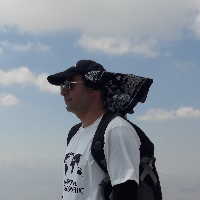Monitoring changes in wind speed and their effect on the displacement of sand dunesin the Lut Desert
Surface winds move and transport soil particles on the ground and thus, affect the intensity of erosion to a great degree (Tage Din et al, 1986: 118). Various studies have found a decreasing trend for surface wind speed in different parts of the world in recent years. This decrease has been more widely reported in mid-latitudes (McVicar et al, 2008). Continuous drought in consecutive years is one of the factors that can reduce soil moisture and stop the growth of vegetation cover. (Hereher at el, 2009). Iran is located in the arid belt of the world and two thirds of its total area is located in these arid regions (Maghsoudi, 2006). Previous studies have shown that 17 provinces of the country are affected by wind erosion, among which Kerman faces a more severe conditions. Iran has more than 20 relatively large ergs and several small ergs covering an area of approximately 36,000 square kilometers (Mahmoudi, 1991). The present study investigates different characteristics of winds and its effects on morphology and displacement of sand dunes using Sentinel-2 optical and Sentinel_1 radar images.
Due to the lack of any synoptic station in the Lut Desert, related data including wind direction and speed were collected from 6 neighboring stations (Bam, Dehsalm, Zabol, Shahdad, Nusratabad and Nehbandan). Then, a wind rose and a sand rose graph were prepared for each station using WR Plot and Sand Rose Graph software. Resultant force vector acting in the displacement of sands and formation of sand dunes was determined. Following an examination of wind characteristics in the study area using Sentinel-2 optical images collected in the 2016 - 2019 reference period, changes of sand dunes and direction of their movements were also analyzed. In order to investigate vertical displacement in the region, radar interference method and SBAS time series have been used. This method only uses pairs of images in which vertical component of the baseline is less than its critical value, and also have a minimum baseline time. 45 Sentinel_1 radar images were used in the present study to measure radar interference.
Recorded data in Dehsalm, Nehbandan, and Nosrat Abad stations indicate that winds blowing in these stations affect the Lut Desert. The prevailing wind recorded in Dehsalm station blows in northwest to southeast direction of the Lut Erg, while in Nehbandan station, the prevailing wind blows in north to south direction of this Erg. The prevailing wind in Nosrat Abad station blows in southeast to northwest direction of this erg. Sand rose graphs show that DPt in Dehsalam station equals 422.6 and in Nehbandan station equals 484.2. Since both DPts are more than 400, wind in this region has a high energy level and is potentially capable of sand displacement. Changes of sand dunes and direction of their movements were analyzed using Sentinel-2 and Sentinel-1 images in 2016-2019 reference period.
Hourly wind speed and direction data in Nehbandan, Dehsalam, and Nosratabad stations were investigated in the present study to evaluate their impact on geomorphological changes in the Lut Erg and its sand dunes. Results indicate that the prevailing wind in these stations blows in north, northwest and southeast direction towards the Lut Erg, respectively. Investigating wind speed changes in Nehbandan station shows that during the last 34 years, average monthly wind speed in this station has decreased from 3.7 meters per second in 1986 to about 2.2 meters per second in 2020, which means a 1.5 meters per second decrease has occurred during this period. Apart from wind speed and direction data, Sentinel-2 optical images were also used to monitor changes in sand dunes of the Lut Erg. Results indicate that during the 2017 - 2018 reference period, most changes have occurred in the sand dunes of the northwest and northeast regions and the margins of this erg, while in the 2018 - 2019 reference period, most changes have occurred in the northwest and southeast regions of the Lut Erg. Analysis of satellite images indicates that the direction of wind force vectors is consistent with the direction of sand transport vector. In other words, sand dune changes in the Lut Erg have occurred under the influence of winds blowing in northwest and southeast directions, which is consistent with the direction of the sand transport vector in plots prepared for the three stations (Nehbandan, Dehsalam, and Nusrataba). In order to validate the results of wind direction and speed analysis and remote sensing of optical images, vertical displacement of the erg surface was measured in 4-year periods using Sentinel_1 radar images and SBAS time series. In general, southern parts of the Lut Erg and especially sand dunes in these parts have experienced an increase in elevation, while the northern parts of Erg have experienced a decrease in elevation. This can be due to erosion and deposition of sediments in the southern regions of the Lut Erg, which is consistent with the sand rose and wind rose graphs prepared for the region .
- حق عضویت دریافتی صرف حمایت از نشریات عضو و نگهداری، تکمیل و توسعه مگیران میشود.
- پرداخت حق اشتراک و دانلود مقالات اجازه بازنشر آن در سایر رسانههای چاپی و دیجیتال را به کاربر نمیدهد.




